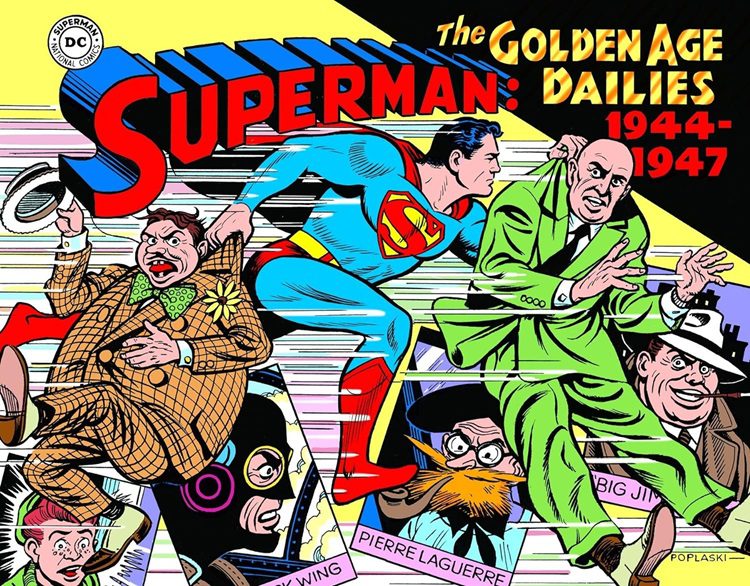
Superman’s adventures have been written about for 80 years now — a remarkable number for any character. He has been the subject of comic books, radio dramas, television shows, animated series, movies, and newspaper strips. The newspaper strips, which ran from 1939 to 1966 and saw the character witnessing an astonishing amount of social change in the United States, have become some of the rarest Superman collectibles. In an attempt to rectify this, DC Comics has partnered with the Library of American Comics and IDW to reprint these classic tales in lovingly assembled volumes, the latest of which is Superman: The Golden Age Newspaper Dailies (1944-1947).
In 1944, World War II was still in full force and Superman (and Clark Kent and Lois Lane by proxy), not unlike Captain America, was considered the literal embodiment of all that was good and American. In “Lois Lane, Millionaire,” an amusing tale where Lane learns she has been left $3 million if she marries within 10 days, we see Reggie Vaine’s humorous, if futile attempts to get Lane to marry him while Lane, of course, wishes she could be marrying Superman. Kent, who has gotten nowhere with Lane, ponders revealing his identity to her to see if she’d be interested.
When asked how she would invest her fortune, she says in “war bonds, of course.” Kent agrees that it is a “swell idea.” It’s one panel, but this sort of pro-America propaganda filled these strips, such as in “Superman’s Secret Revealed,” when Superman compares dollars spent on war bonds to putting together bricks that “form a mighty bulwark against our enemies.”
DC managed to find themselves on the wrong side of the U.S. government though, albeit unintentionally, with its 1945 story “The Science of Superman.” With the Manhattan Project still being top secret and the first atomic bomb test still months away, any mention of anything remotely nuclear related was forbidden in the press. The mention of atom smashers and cyclotrons in the strip prompted an investigation by the FBI, which later concluded that the cyclotrons in the story were nothing like the real thing and therefore not a threat to national security.
The volume concludes with “Juvenile Delinquency,” with the strip, and Superman himself, examining the problems with the youth of the day and the possible causes for this behavior. The strip featured 21 different speaking roles and a very different Superman than what we might be used to seeing today. In one series of panels, he disguises himself as a robbery victim, even allowing the criminal to think he had killed him to make a point about the life choices they were making. In another instance, Superman probes the mind of a car thief to get inside his thoughts. The thief finds this unfair but Superman reiterates that stealing a car is unfair too. While Superman has always been the ultimate do-gooder, this is over the top, even for him. It is an interesting depiction of the character to be sure and one we don’t quite see anymore.
Written by Alvin Schwartz and illustrated by Wayne Boring, nearly 800 daily strips over 16 storylines are included in the volume, which also includes an introduction by Sidney Friedfertig and a cover by Pete Poplaski. This is the first time these strips have been collected together since they originally appeared in newspapers in the 1940s. Everything about the book is top notch, right down to the print quality and reproduction of the strips.
Superman: The Golden Age Newspaper Dailies 1944-1947 is a wonderful time capsule for fans. Impeccably presented in a fantastic book, the stories follow Superman, and really America, from the end of World War II to the immediate post-war era. Much as we changed as a country after the war, so too did the characters in these strips. The collection is an important document of the times and a must-own item for fans.